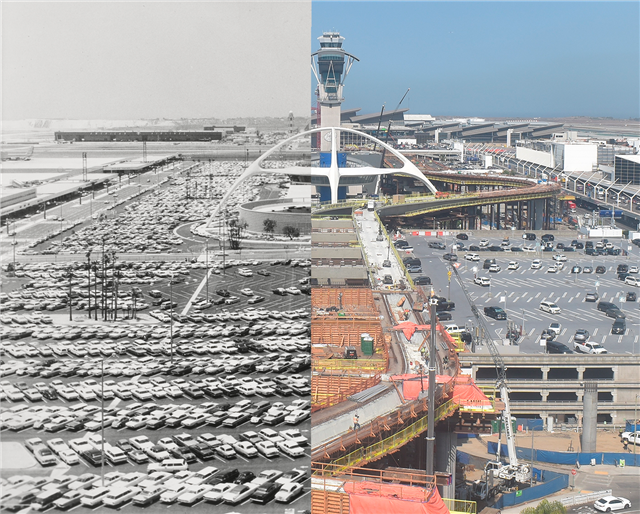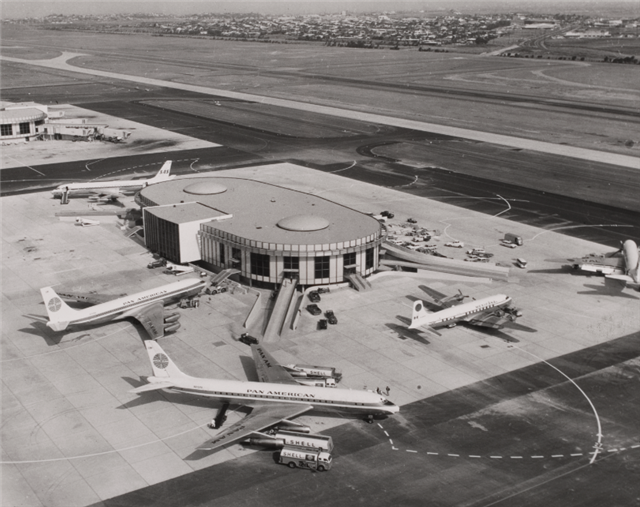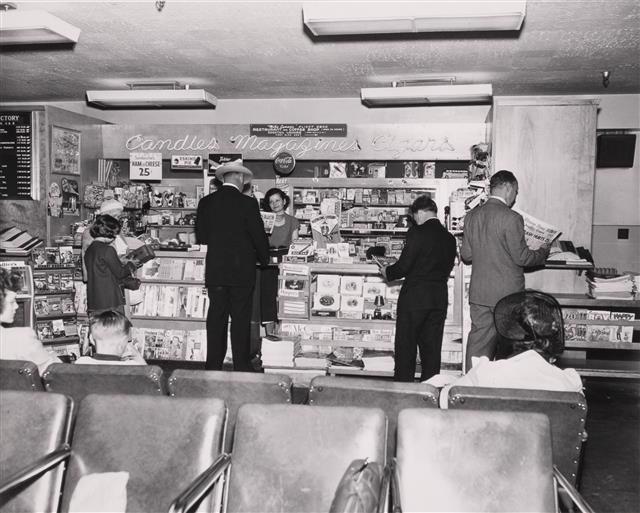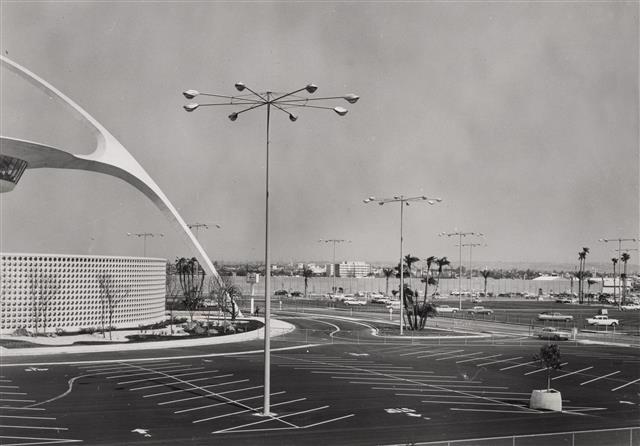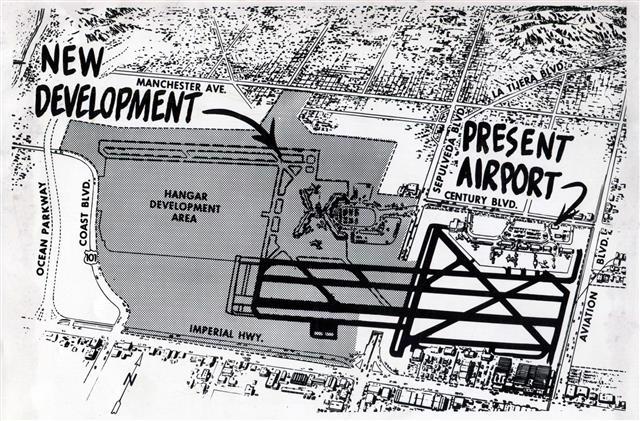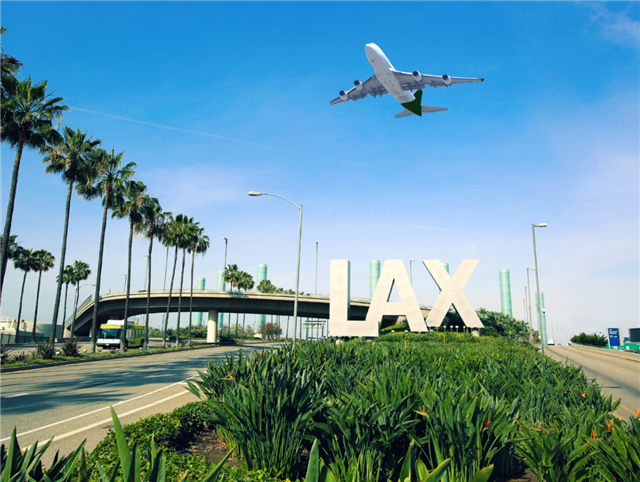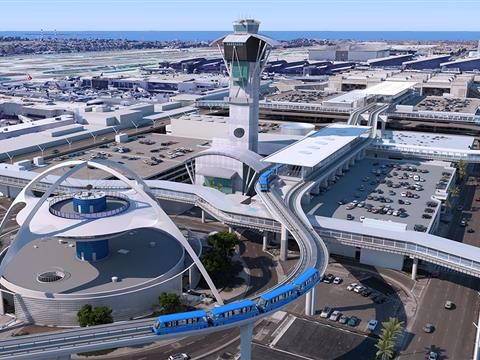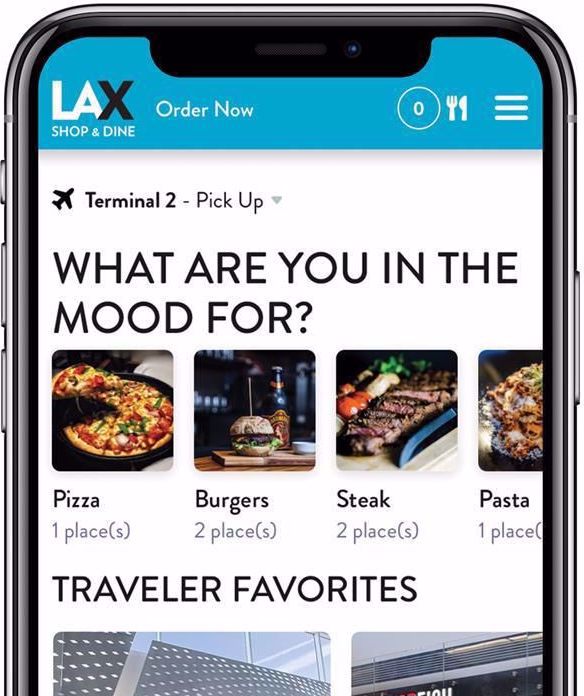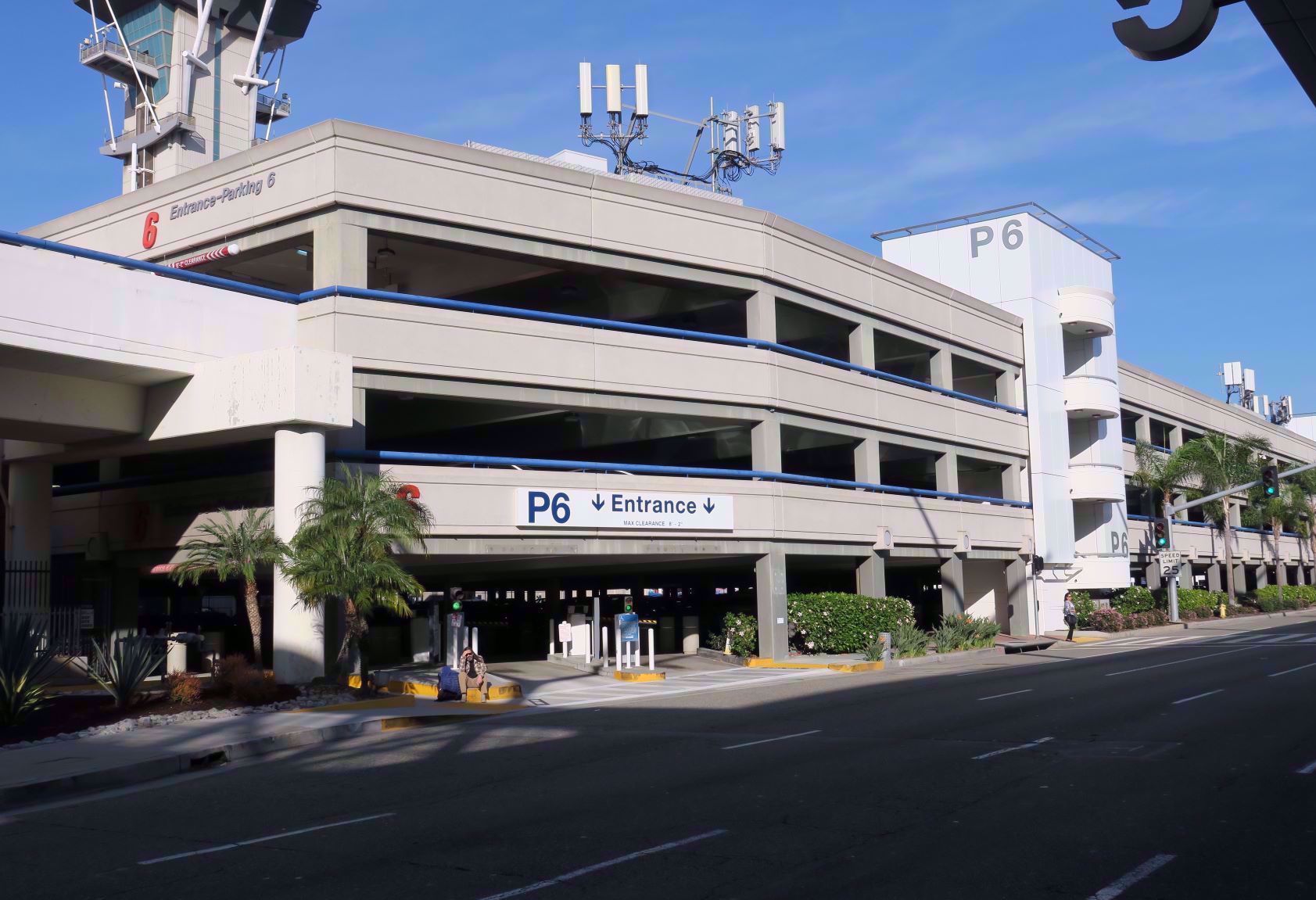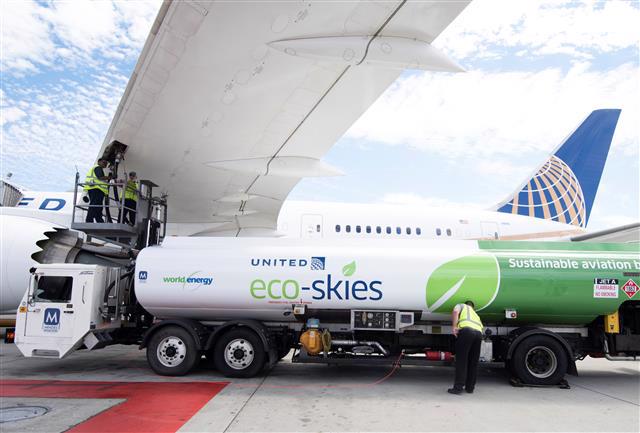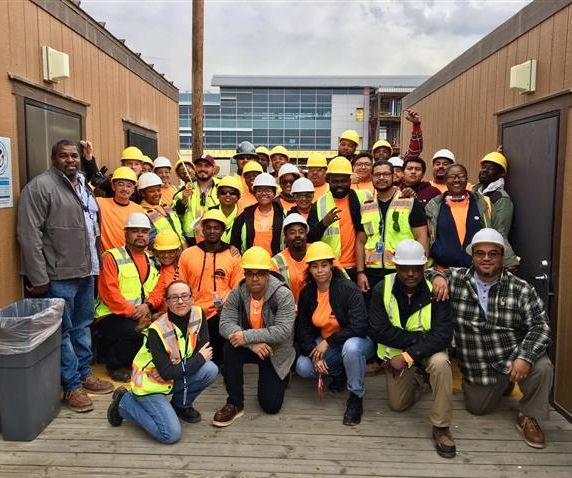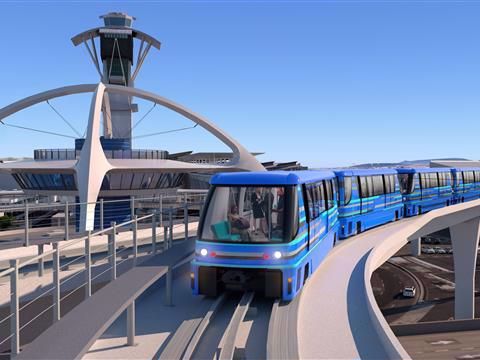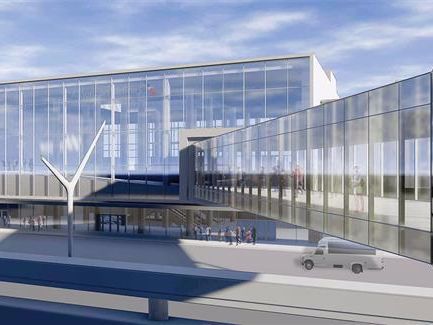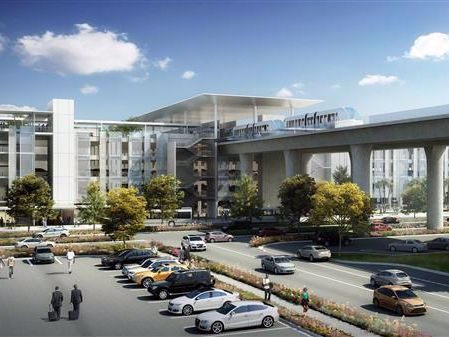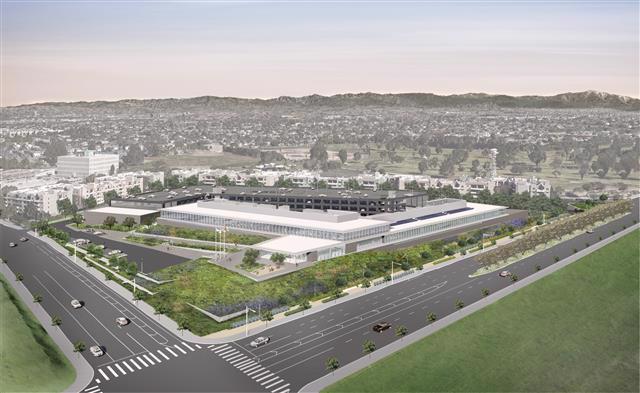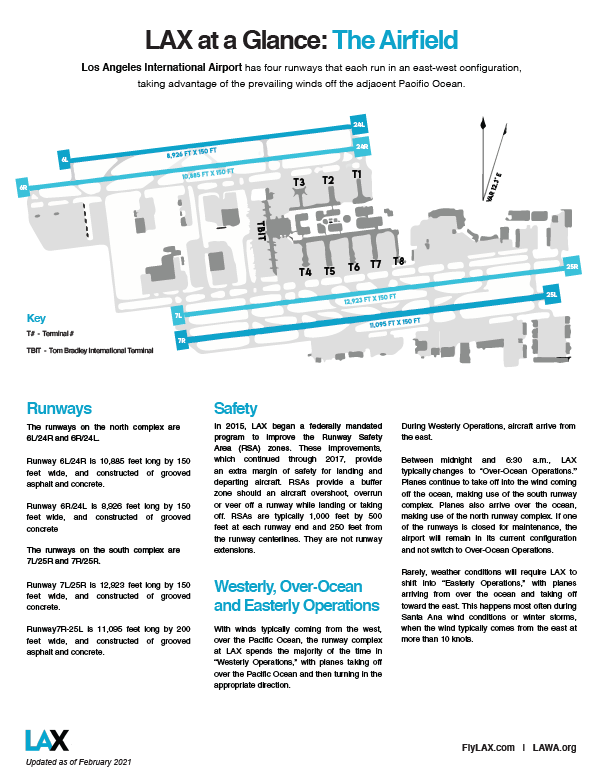|
LAX CELEBRATES 60th ANNIVERSARY OF THE 'JET AGE' TERMINALS AS ICONIC AIRPORT ENTERS NEW AGE |
|
|---|
|
This composite image shows the Central Terminal Area of LAX in the 1960s (left) and today. Over the past 60 years, the airport has reimagined itself several times, and is once again on the cusp of the most ambitious modernization of any U.S. airport. |
|
|---|
|
A MESSAGE FROM JUSTIN ERBACCI
CEO, Los Angeles World Airports
In May of 1961 the New York Times proclaimed there was a "spectacular airport opening in Los Angeles." It was a pronouncement that the "Jet Age" of airport design was here, as Los Angeles International Airport (LAX) set new standards for air travel around the world with its revolutionary design and unrivaled passenger amenities.
On opening day, June 25, 1961, the new LAX offered six new satellite terminals with a radical modular layout and underground passageways, 5,000 parking spaces, and the now iconic Theme Building – which offered admission to its observation deck at a cost of 50 cents for adults or 25 cents for children, with a coffee or cold drink included. The world was greatly impressed at this progressive, elegant airport that was the epitome of mid-century design, and that revitalized the golden age of travel using aircraft that were modern miracles of aviation.
Today, we acknowledge our proud history and heritage with the 60th anniversary of the Jet Age terminal dedication at LAX. More importantly, we also celebrate our future, which has never been brighter. For an airport that has evolved constantly during its nearly 100-year history – from a bean field in Westchester to one of the busiest airports in the world – there is a historical significance to this moment in time. We find ourselves once again on the cusp of unveiling yet another new age for air travel in Los Angeles.
Our $14.5 billion modernization is reimagining the LAX experience. The Automated People Mover train will fundamentally transform how tens of millions of people access the airport each year. Every terminal has been or will be modernized with the latest in technology and amenities. We are creating a digital marketplace in which passengers will be able to control most of the aspects of their journey from their phone, from reserved parking with automatic payment to streamlined mobile food ordering and delivery. And we will do so sustainably, with bold goals to become carbon neutral by 2045.
These and other projects allow LAWA to continue in its role as an important driver of the Southern California economy, providing thousands of local jobs and business opportunities.
At the same time, we are preparing to meet the demands of the future while staying within our existing footprint, with the environmental review process underway for airfield safety improvements, a new concourse and terminal, and elevated roadways to separate airport traffic from neighborhood traffic. We are doing all of this while being responsible, first-class neighbors to our community and engaging with local residents as we build the future world-class airport Los Angeles deserves ahead of the spotlight of the 2028 Olympics.
Below is a snapshot at how far we have come, and where we are going, as our history of innovation and imagination repeats itself at LAX.
Justin Erbacci
Chief Executive Officer, Los Angeles World Airports
|
|
|---|
|
In December 1957, Los Angeles embarked in one of the West's most complex construction projects with the construction of the modern LAX. When the satellite terminals opened in the summer of 1961, they were a modern marvel that reset public expectations of what air travel could be. New technology included automated doors, moving walkways, automatic parking pay machines, a telephone system that took four years to engineer, covered jet bridges and complex baggage conveyers. The airport was configured around a Central Terminal Area and saw daily activity including 20,000 passengers, 40,000 visitors and 32,000 workers employed by 158 tenants. Click here to view the 1960s documentary, "#1 World Way, the Story of Los Angeles International Airport." |
|
|---|
|
Terminals: In the summer of 1961, the new Jet Age LAX opened with six satellite terminals and a seventh concourse (connected to the United Airlines ticketing building). This new, modern facility made up the original Central Terminal Area (CTA) at the airport. Each satellite building was connected to its ticketing building (located on World Way) by a 300- to 400-foot tunnel. This was a radical new approach that influenced airport design for a generation. |
|
|
|
|
Airlines: Operations at the redesigned LAX began at Terminal 7 in August 1961, and a total of 19 airlines served the airport at the time. International carriers flew from Terminal 2, with Trans World Airlines at Terminal 3, American Airlines at Terminal 4, Western Air Lines at Terminal 5, a group of regional airlines at Terminal 6 and United Airlines at Terminal 7 and the connected concourse. |
|
|
|
|
Shops and Dining: Each of the new satellite terminals included a coffee shop and a sit-down restaurant with an attached cocktail lounge. A total of 21 dining rooms, bars, gift shops and newsstands were open. Each of the locations had a California or Western theme, including "Early Days of the Movie Industry" and "Famous Sights of Los Angeles." They were constructed at a cost of $3 million to be "among the most spectacular in Southern California," according to a 1961 press announcement. It was predicted the restaurants would sell 580,000 hamburgers each year. |
|
|
|
|
Parking and Access: Most parking in the Central Terminal Area was in surface lots, including the site of the future Terminal 1, with a capacity of 5,000 cars, making it the world's largest airport parking facilities at the time. Some metered parking also was available at a cost of 25 cents for three hours. The Central Terminal Area had only the ground-level roadway until a second level was constructed in the 1980s. |
|
|
|
|
Airfield: Three runways were available in 1961, two on the south side of the airfield and one on the north side. FAA controllers worked from a 172-foot tall tower that was among the first structures to open in the new Central Terminal Area. The FAA tower managed 1,000 flight operations every 24 hours with eight controllers on duty. |
|
|
|
|
Theme Building: A central point of the new Jet Age facilities, the Theme Building quickly became the symbol of mid-century design and synonymous with LAX. Upon opening, the building included an observation deck, a Bank of America branch, a "Sky Gourmet Restaurant," barber shop, gift shop, employee cafeteria and central kitchen and commissary which served all the satellite terminal restaurants and lounges. The building was designed by a team that included famed LA architect Paul Revere Williams. |
|
|
|
|
Technology: The new satellite terminals featured new technology including an underground, automated baggage movement system with magnetic coding for sorting bags. Other innovations were pre-recorded information boards activated by push button, automatic flight information display boards and covered loading bridges. |
|
|
|
|
- The project included 1.2 million square feet of buildings and 175 acres of pavement, including parking lots and airfield surface
- The drainage complex utilized six miles of reinforced concrete pipe
- 19 miles of underground electrical conduit were laid
- Three miles of sewer lines were installed
- Thirty miles of underground lines carrier jet fuel
- 38,000 miles of wire and cable were installed by Pacific Telephone Co.
- 6,500 rolls of roofing felt covered the new terminals
- A half-million square yards of plaster was installed, enough for 900 average homes at the time
- 29,000 lighting fixtures were installed
- 165,000 tons of concrete was used
|
|
|---|
|
LAX has become the economic engine for the Los Angeles region, generating 620,600 jobs in Southern California, with labor income of $37.3 billion and economic output of more than $126.6 billion, according to an economic study based on 2014 operations. This activity added $6.2 billion to local and state revenues and $8.7 billion in federal tax revenues. The airport is in the midst of a $14.5 billion modernization program, which will fundamentally transform how people access and experience Southern California's premier international airport. With the 2028 Olympics around the corner, LAX is setting the stage for the next 60 years of air travel with fully modernized facilities, new technology, enhanced amenities and reimagined access via an Automated People Mover train. |
|
|---|
|
Modernization: The $14.5 billion modernization of LAX continues to make significant progress, focused on not only modernizing the terminals, but creating new and better ways to access the airport. After breaking ground on four of these projects in 2019, 2021 is a year of ongoing progress and completions. So far this year, the stunning new West Gates at Tom Bradley International Terminal and an extension to Terminal 1 have both opened. Later this year, a new approximately 4,300-space parking facility will open to the east of the airport, followed by the opening of a new Airport Police Facility. Meanwhile, the Automated People Mover train system and Consolidated Rent-A-Car facility continue to see significant progress. Click here to learn more. |
|
|
|
|
Operations: In 2019, LAX served nearly 88.1 million passengers and offered an average of 700 daily nonstop flights to 113 destinations in the U.S. and 1,200 weekly nonstop flights to 91 markets in 46 countries on 72 commercial airlines. In 2019, LAX was the third-busiest airport in the world. LAX's cargo operations also continue to grow, and so far in 2021 LAX is the No. 3 airport for total global trade by value among U.S. airports. |
|
|
|
|
Technology: LAX is an industry leader with the newest technology including biometric self-boarding gates, the latest-generation Wi-Fi service, touchless check-in kiosks, mobile food ordering and gate delivery via LAXOrderNow.com. The West Gates at Tom Bradley International Terminal includes the most advanced baggage handling system in the country today, along with touchscreen kiosks that can send directions and information directly to passenger phones. LAX partnered with the TSA to be the first U.S. airport to include automated photo identification scanners at every security checkpoint. In the U.S. Customs and Border Protection Federal Inspection Station, a Simplified Arrivals process uses biometric photo identification to automate formerly manual document checks and saves up to 45 minutes by eliminating the need to line up a second time. |
|
|
|
|
Parking: LAX in transforming its parking into a $303 million smart system that will enable a passenger-controlled journey that includes reservations, automatic payment and exit, valet service and available space overhead identification. The upgrades also include additional EV charging stations with reservations available and enhanced wayfinding. This summer, LAX will open an approximately 4,300-space parking facility east of the airport. |
|
|
|
|
Mobility: Los Angeles World Airports' new Mobility Strategic Plan lays the framework for revolutionizing landside access to LAX. This plan is a comprehensive roadmap for mobility policy, programs and initiatives that will define how passengers and employees travel to and from the airport into the 2020’s and beyond. Planning is underway to take full advantage of the Automated People Mover upon its completion, and a rejuvenated FlyAway® service is anticipated soon. |
|
|
|
|
Sustainability: LAX is leading the aviation industry in sustainability practices with the LAX Sustainability Action Plan, "Boldly Moving to Zero," setting ambitious targets for becoming carbon neutral by 2045. Those efforts have already resulted in moving to an all-electric airfield bus fleet, expanding a food donation and waste diversion program to all concessions and lounges, promoting the use of sustainable aviation fuel and investing in solar generation at Los Angeles World Airports facilities. In 2019, LAX received Level III ACI Airport Carbon Accreditation from Airport Councils International-Europe. |
|
|
|
|
Equity and Inclusivity: Los Angeles World Airports is committed to supporting the local business community and providing jobs for local workers. In 2020, the airport updated its procurement standards to ensure that commitments to employ local, small, disadvantaged businesses and local workers factor significantly in vendor selections for the approximately $500 million in goods and services that LAWA purchases annually. This new policy helps translate LAWA's core values of diversity, equity, and inclusion into strong, enforceable contract language for companies doing business at LAWA. The HireLAX apprenticeship readiness program is preparing people for a career in skilled construction, and has so far connected more than 170 people from the local community with rewarding career opportunities and earned graduates more than $7 million in wages to date. |
|
|
|
|
Community Engagement: LAX continues to reimagine our support for local communities in ways that reflect our commitment to the region. We focus on being good neighbors and continue to offer beneficial programs, services and opportunities as involved members of the airport community. LAX maintains a strong community presence by participating and representing LAX in a wide array of community and civic organizations. We also support tomorrow’s leaders in a variety of ways including our annual Aviation Careers Education Academy, Aviation Career Day, Network For Teaching Entrepreneurship, Read Across America Day Celebration, LAX Job Shadow day, Santa Fly-In and more. |
|
|
|
|
LAX is in the midst of a $14.5-billion Capital Improvement Program that will completely transform LAX into a world-class airport. With the Automated People Mover train system opening in 2023, passengers and employees will find a much easier way to access the busy Central Terminal Area, and the long-awaited connection to regional transportation. Terminals 2, 3, 4, 5 and 6 are also undergoing modernization projects to enhance the guest experience greatly once completed. And, the airport has proposed a Concourse 0 and Terminal 9, along with improved roads to access the airport and relieve traffic in the area. LAX is on the cusp of a reimagined airport that will be built with the future in mind. |
|
|---|
|
Automated People Mover: The 2.25-mile elevated guideway is now more than 60% complete, while station construction has commenced at three of the six station locations. The assembly and testing of train cars is underway in Pittsburgh, as the first of 44 train cars that will run on the system will be delivered to LAX in 2021. The first of six steel structures for pedestrian bridges that will connect terminals to the People Mover stations was placed in June, with the remaining to be installed over the next year. |
|
|
|
|
Terminals: Several terminal projects within the Central Terminal Area have made significant strides as well. The extension of Terminal 1, which provides increased baggage and screening areas, as well as a future connection to the Automated People Mover system, opened in May. The renovations of Terminals 2 and 3 took advantage of the downturn in traffic at LAX by closing Terminal 3 to the public, which in turn is helping to accelerate the project schedule by approximately 18 months, with a targeted completion date of 2023. |
|
|
|
|
Intermodal Transportation Facility-West: The Intermodal Transportation Facility-West is a new, approximately 4,300 stall parking structure that will open later this summer, offering both short-and long-term parking. The facility will provide an economy option for travelers when it opens, and will feature the latest in smart-parking technology to create a streamlined parking experience. In 2023, the facility will connect to the Automated People Mover train system, while a shuttle bus will transport travelers to and from the Central Terminal Area in the interim. |
|
|
|
|
Consolidated Rent-A-Car Facility: What will become the largest rental car facility in the world once completed is visible from the 405 freeway. The three buildings that comprise the 6.3 million square foot facility – the Ready Return, Idle Storage and Quick Turn Around – will top off in concrete in July. The facility will connect to an Automated People Mover station and provide a streamlined rental car experience for the hundreds of thousands of travelers who rent cars each year. |
|
|
|
|
Airport Police Facility: The new 160,000-square-foot facility will consolidate police operations into one location on the north side of Westchester Parkway. The project officially topped out in August as it moves toward completion in the fall of 2021. |
|
|
|
|
Click on the links below to learn more about LAX.
|
|
|
|
|
| |
|
| |
|
|



